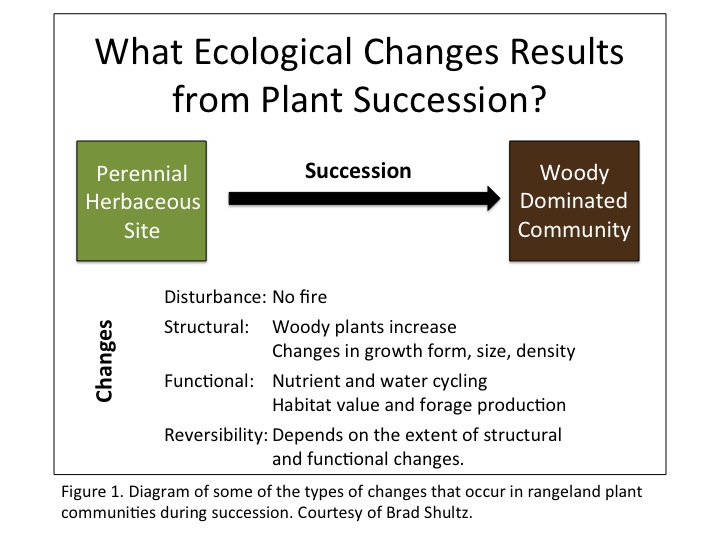Past Plant Succession Models
Vegetation change and succession on rangelands was historically measured or modeled with the Range Condition and Range Succession Models. These two models are structurally similar but differ in their terminology. Both models viewed plant succession, both before and after disturbance, as a linear process (Figure 2). Following a disturbance, early seral species typically inhabit an ecological site. With time, the plant community progresses through a series of changes toward a potential natural community, or climax community. All plant communities are subject to many stresses that influence the composition and structure of the vegetation. Under the Range Succession and Condition models, little or no stress resulted in vegetation change toward the potential natural community (PNC). Increasing stress above some community specific level would prevent succession toward the PNC and could return the community to some prior composition, lower on the successional ladder.
To describe the stage of succession at any given time, both models compared the current plant composition to the PNC or climax community described. The percent of overlap between the current community and the PNC determined the stage of plant succession and condition of the site. The four categories used were early seral or poor condition; mid-seral or fair condition; late seral or good condition; and the potential natural community or excellent condition. Seral stage descriptors formed the basis of the Range Succession model and condition descriptors the Range Condition model.
Figure 2. Conceptual diagram of the Range Succession and Range Condition models for describing plant succession on rangelands. Courtesy of Brad Shultz.
From the 1960s through the 1980s, range management specialists and research scientists identified a number of problems with the Range Condition and Succession models. Vegetation change did not always follow the linear pathway the models suggested, and some plant communities were very resistant to change, regardless of changes in management. The most significant problem was that the same condition class or seral stage can be achieved with very different species compositions and even very different lifeforms. Data in Table 1 are from a series of Wyoming sagebrush sites (Loamy 8-10 ecological site for central Nevada) illustrate this problem.
Table 1. Vegetation composition by annual biomass production for three Wyoming sagebrush ecological sites (Loamy 8-10 inch) and their range condition and succession scores.
| Site Description (PNC) | Site 1 | Site 2 | |||
| Percent (%)* | Percent (%) | Overlap (%) | Percent (%) | Overlap (%) | |
| Shrubs (45%) | |||||
| Wyoming sagebrush | 25-35 | 70 | 35 | 17 | 17 |
| Rabbitbrush | 2-5 | 5 | 5 | 3 | 3 |
| Other | 5-10 | - | - | - | |
| Grasses (50%) | |||||
| Indian ricegrass | 20-30 | 9 | 9 | 15 | 15 |
| Thurber's needlegrass | 10-20 | 6 | 6 | 27 | 20 |
| Squirreltail | 2-8 | 3 | 3 | 15 | 8 |
| Sandberg's bluegrass | 2-5 | 1 | 1 | 10 | 5 |
| Other perennial grasses | 2-8 | 0 | 0 | 10 | 2 |
| Cheatgrass | 0 | 5 | 0 | 0 | 0 |
| Forbs (5%) | |||||
| Globemallow | 2-5 | 1 | 1 | 2 | 2 |
| Other | 2-5 | T | T | 1 | 1 |
| Total/Overlap | 100 | 60 | 100 | 73 | |
| Condition Class | Good | Good | |||
| Seral Stage | Late | Late |
The data in Table 1 show that a potential plant community can have several very different seral stages with the same classification for range condition class or seral stage. Site 1 is a shrub-dominated site with relatively few perennial grasses. Site 2 is predominately a bunchgrass site with few shrubs. Species and particularly life-forms often respond to fire and other disturbances quite differently. The response of both seral stages to the same management action or the same catastrophic disturbance probably will not be the same, despite both having the same classifications for range condition and successional status. One of the serious flaws of the range succession and condition class models is that the same descriptive classification — for example, good/late — can represent two different phases of plant succession and therefore two very different response potentials to management and disturbance. If the descriptive classifier is the only data product retained by the land manager, the manager will not know the response potential of the ecological site following disturbance.
Figures 3a-3c are pictures of the same sagebrush ecological site in three different community phases. Figure 3a is the potential natural community. The community phases in Figures 3b and 3c are both late seral/good condition communities but with very different plant communities. The shrub-dominated site (Figure 3b) will have substantial bare ground after a disturbance and would be very susceptible to invasion by non-native annual grasses or other weeds. The other two sites (Figures 3a and 3c) have sufficient perennial bunchgrasses to remain bunchgrass sites after a disturbance and resist the invasion of annual grasses. The need to better understand the management opportunities and hazards associated with the different community phases for any ecological site’s reference community led to the development of state and transition models.

and Figures 3b and 3c are different community phases of the reference community. Courtesy of Brad Shultz.
